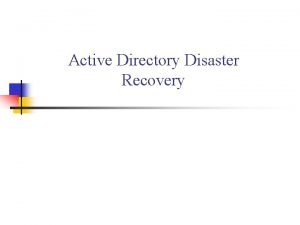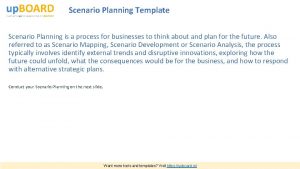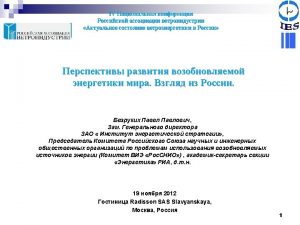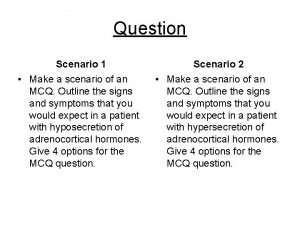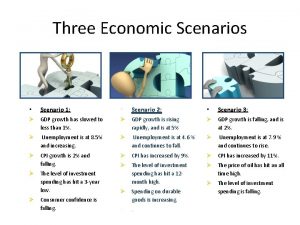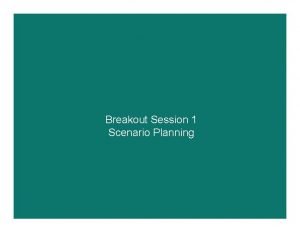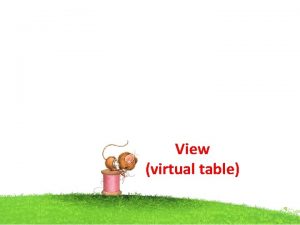Scenario Planning July 2020 View Scenario Planning Overview






















- Slides: 22

Scenario Planning July 2020 View Scenario Planning Overview

Scenario Planning 1 of 2 ≫A method to prepare for a range of plausible futures based on a set of different “uncertainties” ≫Expands thinking ≫Uncovers inevitable or near-inevitable futures > Demographic trends, economic action and reaction, reversal of unsustainable trends, scheduled events ≫Protects against groupthink ≫Turns organization into crisis prepared, not crisis prone 2

Scenario Planning 2 of 2 ≫Used to address turbulence: “When there are sudden changes in the environment and the structural properties of objects, [systems], show their inadequacies. ” ≫Creates a way to analyze the organization in a variety of conditions. ≫Most useful when the environment is changing too rapidly for most strategic planning models or processes. ≫Can be used to inform revisions to a strategic plan. (Chermack, 2011) 3

There are numerous scenario planning processes/approaches – we have modified them for education 4

Eight steps to help systems move from scenario planning to implementation 5

Foundational Principles A good scenario: ≫Incorporates the organization’s vision, mission, values, and goals ≫Focuses on two to five scenario narratives ≫Includes enough detail to allow for trade-off discussions and enable implementation ≫Focuses on strategies that prepare for reinvestment 6

Planning Steps 1. Preparation. Who are you working with, who are you bringing to the table, when and how? > Be specific with roles and responsibilities 1 of 5 2. Select focus. What specific issue are you trying to address? > Be specific and realistic – Open safe schools 7

Planning Steps 3. Identify critical uncertainties. What are the key issues that affect your ability to reach your goal? > Balance between creativity and good judgment > Select top 2 -4 – economic downturn, workforce, physical distancing 2 of 5 4. Develop a range of plausible scenarios. What are the outcomes when the “uncertainty” becomes a reality? > Who is affected? > How are they affected? > What are the risks to your goal? 8

Planning Steps 3 of 5 5. Discuss the trade-offs, implications, and pathways. What does your organization need to do (and who needs to do it) when a scenario is enacted? > What systems or processes need to change? > What do you stop doing? > How easy is it to “do” / “undo”? > Have you set yourself up for reinvestment, or did you create a new status quo? (Gather information for prioritized actions. ) > What is your decision framework to enact next scenario? 9

Planning Steps 6. Create a strategy and action plan for implementation. Select a scenario, identify strategies, and begin implementation. > Have the right people at the table. > Focus on strategic options that look good in any and all of the scenarios. 4 of 5 7. Monitor, reflect, and revisit with new data (based on the 3 biggest uncertainties). If any of your uncertainties change, what do you do? > Re-run foundational information that affected scenarios > Enact decision framework > What are the deadlines? > What are the contingencies? 10

Planning Steps 5 of 5 8. Assess your efforts and impact. Assess the project and document the results > Examine the original question > Use a variety of measures > Determine how learning has affected behaviors > Include cost-benefit analysis 11

* Step Scenario Planning Process Prepare Focus Who, when, how? What issue are you trying to address? • Be specific on roles and responsibilit ies Unknowns What are key issues that affect your ability to reach your goal? • Be specific and realistic Ex: Economic Ex: Open schools safely. downturn, workforce, physical distancing Scenarios What are the outcomes when the “uncertainty” becomes a reality? Trade-offs What does your organization need to do (and who needs to do it) when a scenario is enacted? Action Identify strategies, develop actions, and begin implementa tion. Monitor If any of your uncertainty changes, what do you do? Assess Evaluate and document impact and results • Multiple measures • Re-run foundational • Multiple information domains that affected scenarios. • Enact decision framework. 12

Scenario Planning Example Org Mission Scenario 1 Scenario 2 Scenario 3 Scenario 4 Budget Changes Status Quo 15% Reduction 20% Reduction 30% Reduction Physical Distancing Status Quo 6 ft No physical interaction Close mid-year Workforce Status Quo 10% of workforce 25% of workforce 50% of workforce [] What Are Your Non. Negotiables (Values)? 1 of 2 [] Focus Area How do I open schools safely? 13

Scenario Planning Example Org Mission Scenario 1 2 of 2 Scenario 3 Scenario 4 ≫ What is your decision-making framework? What Budget Changes Status Quo 15% Reduction 20% Reduction 30% Reduction triggers a shift in direction? What Are Your Non. Negotiables (Values)? Physical No physical ≫ What is your reinvestment scenario? It is NOT (nor Status Quo 6 ft Close mid-year Distancing interaction should it be) your status quo. Prioritize what to add back first. Status by Quo incorporating multiple voices. Workforce 10% of workforce 25% of workforce 50% of workforce Focus Area ≫ How do I open schools safely? Can you “undo” any of your actions? 14

Real Power of Scenario Planning ≫ Examining the original question > What have we learned that relates to our initial problem or issue? > What different ways of solving our strategic dilemma are suggested? > What are the clear strategic opportunities? > What actions would we recommend? > How does each align or support our goals and current strategies? ≫Testing theory of the business idea > Do our assumptions fit or enable us to take action? > Is our theory known and understood throughout the business? > How can we continually test our theory? 15

Scenario Planning and Strategic Performance Management ≫Do we have a viable strategy for each scenario? In which scenario does our strategy fall apart? ≫Does our organization structure support the kind of organization we might be in each scenario? ≫Is our organizational culture an asset or liability in each scenario? ≫Do we have the necessary leadership and human resource capacity to maintain our theory of action in each scenario? (Chermack, 2011) 16

Alignment Scenario A Scenario B Scenario C Scenario D Theory of Action Strategy Structure Culture Capacities (Chermack, 2011) 17

Pitfalls to Avoid 1. Don’t become paralyzed 2. Don’t let scenarios muddy communication – do not communicate with scenarios 3. Don’t rely on an excessively narrow set of outcomes 4. Don’t chop off the tails of distribution 5. Don’t discard scenarios too quickly 6. Remember when to avoid scenarios all together Roxburgh, C. (2009). The Use and Abuse of Scenario Planning. 18

How to Get Started ≫Make sure decision-makers understand what scenario planning is really about along with the time and commitment needed to be successful ≫Obtain commitment and support for the planning project ≫Identify a key point of contact internal to the organization who shares responsibility ≫Spend time on the problem, issue, or question ≫Spend time on analysis ≫Define important outcomes ≫Put scenarios to use ≫Assess impact 19

Remember the Foundational Principles ≫Incorporates the organization’s vision, mission, values, and goals ≫Focuses on two to five scenario narratives ≫Includes enough detail to allow for trade-off discussions and enable implementation ≫Focuses on strategies that prepare for reinvestment 20

Questions About Scenario Planning? 21

References/Resources Chermack, T. J. (2011). Scenario planning in organizations: How to create, use, and assess scenarios. San Francisco: Berrett-Koehler Publishers, Inc. Forbes Media (2015). Strategic planning and strategic forecasting. Retrieved from https: //www. planning. org/knowledgebase/resource/9147560/ Olgivy, J. (2015). Scenario planning and strategic forecasting. Forbes. Retrieved from https: //www. forbes. com/sites/stratfor/2015/01/08/scenario-planning-and-strategicforecasting/#69 ea 078411 a 3 Ramirez, R. (2016). Strategic reframing: The oxford scenario planning approach. New York: Oxford University Press. Roxburgh, C. (2009). The use and abuse of scenario planning. Mc. Kinsey Quarterly SME (n. d. ) Strategic management and planning insights. Retrieved from https: //www. smestrategy. net/blog/what-is-scenario-planning-and-how-to-use-it Wilkenson, A. & Kupers, R. (2013). Living in the futures: How scenario planning changed corporate strategy. Harvard Business Review. 22
 Gcc july 2020
Gcc july 2020 Scenario planning workforce planning
Scenario planning workforce planning Active directory disaster recovery best practices
Active directory disaster recovery best practices Scenario planning template
Scenario planning template Enterprise resource planning example
Enterprise resource planning example Harris burdick pictures captain tory
Harris burdick pictures captain tory Harris burdick uninvited guest
Harris burdick uninvited guest July 1-4 1863
July 1-4 1863 Ruth bruno
Ruth bruno 2001 july 15
2001 july 15 2003 july 17
2003 july 17 July 30 2009 nasa
July 30 2009 nasa Sources nso july frenchhowell neill technology...
Sources nso july frenchhowell neill technology... What is the significance of july 4 1776 brainpop
What is the significance of july 4 1776 brainpop I am silver and exact i have no preconceptions
I am silver and exact i have no preconceptions The cuban melodrama
The cuban melodrama Poppies in july poem
Poppies in july poem Gdje se rodio nikola tesla
Gdje se rodio nikola tesla Ctdssmap payment schedule july 2021
Ctdssmap payment schedule july 2021 July 1969
July 1969 6th july 1988
6th july 1988 Monday 13th july
Monday 13th july On july 18 2001 a train carrying hazardous chemicals
On july 18 2001 a train carrying hazardous chemicals


